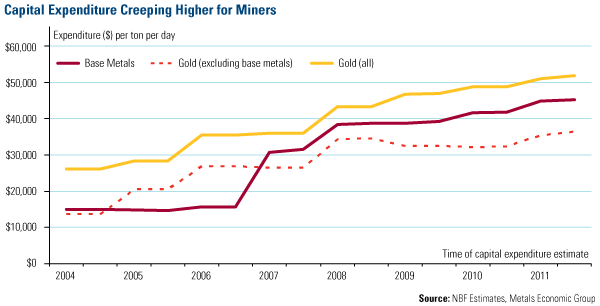Gold Market Radar (January 23, 2012)

For the week, spot gold closed at $1,666.65 up $27.65 per ounce, or 1.7 percent. Gold stocks, as measured by the NYSE Arca Gold BUGS Index, fell 3.4 percent. The U.S. Trade-Weighted Dollar Index slid 1.7 percent for the week.
Strengths
- Gold continues to attract attention as it remained above its 200-day moving average this week and closed above the 50-day moving average on Friday. It had previously crossed below the 200-day moving average on December 14 of last year, and only crossed back above on January 10, giving confidence for higher gold prices to come for the year.
- Traders in India are saying that the current marriage season is being a strong driver for purchases of gold jewelry. They also have said that almost 70 percent of gold jewelry is sold during the wedding and festival season, with the country being host to approximately 10 million marriages a year. Even with current high prices, people appear to spending as much, if not more, this year.
- Romarco Minerals released drilling updates on Friday this week from their Haile Mine, to which the market reacted positively, with shares up 6.0 percent for the day. The project in South Carolina reported an intercept of 21.3 meters with a grade of 43.1 grams per ton from the Snake zone and other strong infill results. Earlier in the week Romarco reported very encouraging drill results from its regional gold exploration program in the Carolinas which was positive for the share price.
Weaknesses
- Catching the market by surprise, India’s government raised the import duty 90 percent on bullion to 2 percent on value from the previous flat rate of 300 rupees per 10 grams. The import duty on silver was also raised to 6 percent on value from 1,500 rupees per kilogram. Trading was light on new orders coming from India, with analysts forecasting that this could have a significant impact on the country’s gold appetite in the long term. As the rupee fell 18.7 percent in 2011, this may be a government reaction to marginally curtail gold buying, but historically the public has found other ways to acquire gold.
- Kinross Gold took it on the front, with shares taking a nose-dive 21 percent on Tuesday after releasing news on possible delays that would impact the Tasiast mine in West Africa and that it was conducting “a capital and project optimization process aimed at improving capital efficiency, project sequencing, and investment returns for its three main growth projects.” Furthermore, the company announced that it expects to record a goodwill charge for Tasiast in connection to the 2010 Red Back acquisition. The Tasiast mine is one of Kinross’s largest sources for future production growth.
- Senior gold mining shares fell better than 5 percent this week while the junior gold mining stocks were up about 1.5 percent. The sell off in the senior names largely reflects generalists rotating out of some of their “fear trade” positions based on some of the better than expected economic numbers. It is very positive though that the junior mining stocks are finally catching a good bid after a dismal 2011.
Opportunities
- China, which is speculated to outpace India in the next few years as the largest gold consumer, recently added more reason to this prediction. Some of the country’s leading banks offer accounts that accumulate gold, and are quickly gaining attention. One bank, the Industrial and Commercial Bank of China, launched the accounts in April 2010 and drew 2.33 million investors by the end of November, just 19 months after the launch, with 22 tons of gold held. Investors buy as little as a gram a month through the accounts, which would quickly add up. The Industrial and Commercial Bank of China has more that 200 million prospective accounts to market its gold products to.
- Eric Sprott, the well-known Canadian fund manager, recently made public his reservations on cyclical commodities, but remained bullish on gold and oil. He cited the ongoing current economic contraction as the main reason for his bearish view on iron ore, coal, steel, lead and zinc. He does, however, expect gold to hit a record above $2,000 an ounce this year, with silver not far behind, reaching an all-time high of more than $50 an ounce. Strong physical gold demand should remain intact with encouraging import numbers coming from China and Turkey late last year. He recently filed last week to launch a platinum and palladium product which would allow investors to redeem the physical metals.
- Argentinean provincial laws banning the use of cyanide in gold processes were repealed for the Rio Negro province, giving a further boost to the mining sector for the country. Pan American Silver said this week that changes to the mining legislation in this province will allow the company to advance its Calcutreu gold development project located in the province. Argentina’s mining industry is continuing to expand with a record $2.57 billion in investments last year.
Threats
- In the midst of earnings season, companies are reporting on average much higher operational costs, namely due to increases in labor, transportation and energy prices. This is a theme throughout the industry, with costs estimated to have increased 10 to 15 percent in 2011. Increases in sustaining capital have also been creeping upwards, giving advantage to the senior names due to their pre-established economies of scale.
- Following the increasing number of its African neighbors, Zambia’s government has introduced a number of policies aimed at tightening the country’s booming mining sector. Analysts view the changes in Zambia as part of a broadening shift throughout the continent toward resource nationalization.
- The Congressional Western Caucus notes on its web site under “Job Killing Policy #10” that “the EPA has also declared the mining industry their number one target for writing rules pursuant to CERCLA §108(b) (Superfund) to require financial assurance. An EPA financial assurance program will be duplicative of federal land management agency and state programs which already have extensive environmental programs and financial assurance requirements in place. Worst-case scenario bonding by the EPA will cause some existing mines to close prematurely and prevent new mines from opening by unnecessarily tying up capital that would otherwise be used to create new wealth and jobs.” Historically, states have had the authority over what could be done on private land but recently the EPA has been asserting that they have authority if air or water might come in contact with development.










